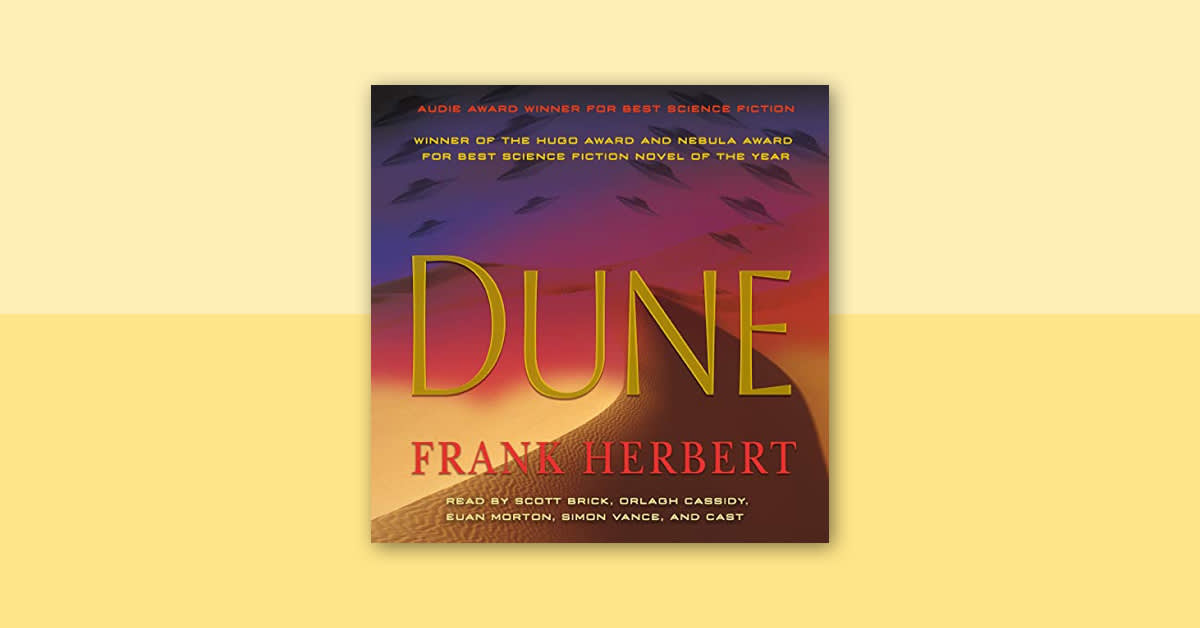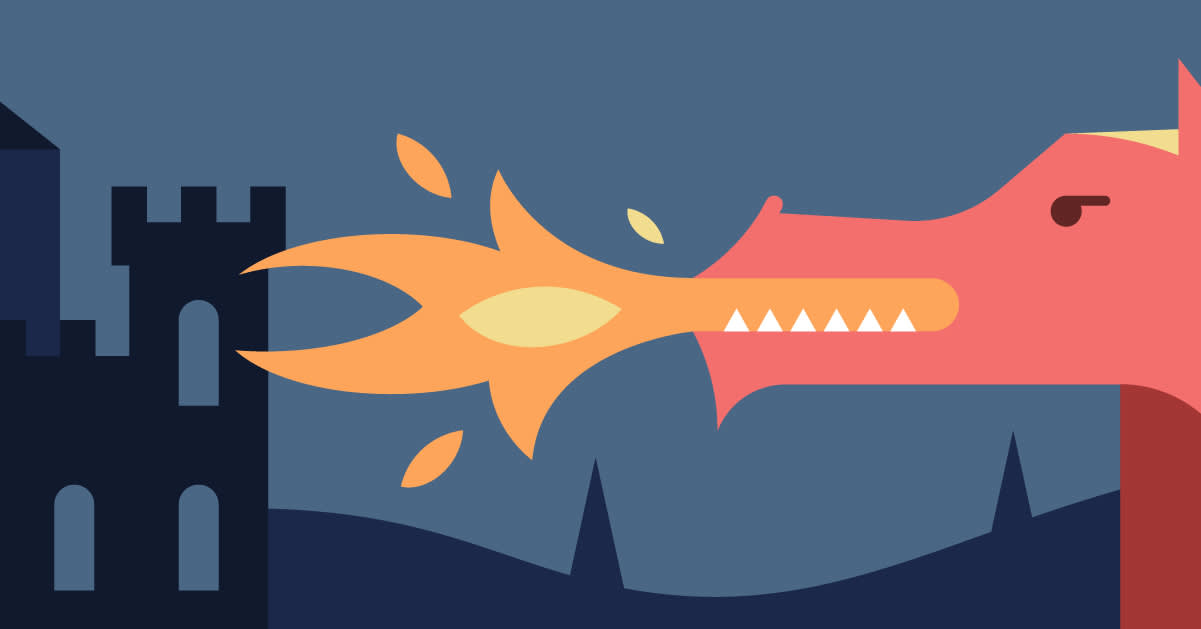Even with all that's been going on in the world this past year, one upcoming Hollywood blockbuster has the internet abuzz: the new Dune movie. It's based on the classic sci fi novel Dune, the first book in an extensive series launched by author Frank Herbert and kept going by writers who took up the helm after his death. The trailer for the upcoming film was released last fall, and since then, speculation and excitement have been swirling around the movie. At three minutes long, the trailer alone is a beautiful masterpiece, and it teases many of the important characters and aspects from the story. What else is in store? Well, we don't have to wait much longer to find out. The film will release simultaneously in theatres and on HBO Max this weekend.
Need a refresher on everything Dune? This post will give you a basic understanding of the book, its history, and everything you need to know before you settle in for the big premiere.
Warning: The following article contains spoilers for the Dune series.
What is Dune about?
Dune is set roughly 20,000 years from now, in the year 10,191. In this future, humans have colonized planets all over the universe. There is a feudal interstellar society of various noble houses, who control planetary fiefs. Duke Leto Atreides, ruler of the ocean planet Caladan, has accepted stewardship of the dangerous planet Arrakis, also called Dune, where he moves with his concubine, Lady Jessica, his son Paul, and his most trusted advisors. While basically an inhospitable desert wasteland, complete with giant sandworms, Arrakis is prized because it's the only place to get the most valuable substance in the universe: melange, or "the spice," a drug that extends human life, provides superhuman levels of thought, and makes faster-than-light travel practical. It is also what drives the Bene Gesserit, an exclusive sisterhood whose members train their bodies and minds with physical and mental conditioning to obtain superhuman abilities.
While Leto suspects the stewardship offer is a trap set by his enemies, the Emperor among them, he cannot refuse, and sets off to run the spice mining operation. He also begins working out a peaceful relationship with the planet's native Fremen people. Anything else about the story would be a spoiler, so let's just say there is a terrible betrayal, and Paul will rise to become the powerful leader he is destined to be.
The first book in the series, Dune was written by Frank Herbert and released in 1965 to great acclaim. It tied with Roger Zelazny's This Immortal for the Hugo Award in 1966, and it won the inaugural Nebula Award for Best Novel. Dune is thought to be the world's best-selling science fiction novel of all time.
What was the inspiration for Dune?
Dune was partially inspired by Frank Herbert’s 1957 trip to see the 40 miles of coastal dunescape, known as the Oregon Dunes, in Florence, Oregon. While the article he wrote about his trip went unpublished in his time, Herbert was quite taken with the dunes. It sparked his interest in dunes and deserts. (That article can now be heard in the fascinating backstory, The Road to Dune.)
Among other inspirations were T. E. Lawrence, the renowned British army officer known for his part in the Arab Revolt during WWI, as well as Herbert's interest in the superhero mystique and messiahs. Herbert has also said that melange, the fictional drug at the heart of Dune, was influenced by hallucinogenic mushrooms. His vision of the spice first appeared in an unfinished short story called "Spice Planet," about a man with a young son living on a hostile planet.
Originally released in eight parts in Analog magazine, Dune was considered a long book at the time—it's 412 pages—but it's quite easy to get lost in. With its fantastic, extensive world-building, imaginative storylines, and really compelling dialogue, Dune was light-years ahead of other science fiction novels when it made its debut.
Who are Dune's main characters?
Paul Atreides
Paul Atreides is the son of Duke Leto Atreides and Lady Jessica, and heir to the House of the Atreides. He is the central character of the first Dune books.
Duke Leto Atreides
Leto Atreides is the 20th Duke of House Atreides, and he is sometimes referred to as "Leto the Just" or "The Red Duke."
Gurney Halleck
Gurney Halleck is a loyal warrior of the Atreides. He is in service to House Atreides and teaches Paul how to fight.
Lady Jessica
Lady Jessica is a Bene Gesserit and concubine of the Duke. She uses her considerable talents to help protect her family and get Paul ready for what she knows is his destiny.
Duncan Idaho
Duncan Idaho is a fearless swordmaster in service of House Atreides. An expert in stealth tactics, he acts as the eyes and ears for Duke Leto.
Gaius Helen Mohiam
Gaius Helen Mohiam is a Bene Gesserit Reverend Mother who once trained Paul's mother, Lady Jessica, and now seeks to test Paul before he leaves for Arrakis.
Wellington Yueh
Wellington Yueh is a skilled doctor who has been a part of the closest inner circle of House Atreides for some time.
Thufir Hawat
Thufir Hawat is the Master of Assassins for House Atreides. Head of security, he is a phenomenal strategist and possesses a mind sharper than a supercomputer.
Baron Vladimir Harkonnen
Baron Harkonnen is the head of House Harkonnen and the chief antagonist of Dune. He feeds off malevolence and wields his ability to float through the air with the help of his gravity-defying suit.
Glossu "Beast" Rabban
Glossu "Beast" Rabban is the older nephew of the Baron. A fearsome figure known for his uncontrollable rage, he works as an enforcer for his uncle.
Chani
Chani is a skilled Fremen fighter and Paul's love interest. She was born on Arrakis and will do anything to defend her people.
Stilgar
Stilgar is the Fremen chieftain, a wise, respected, and fearless leader.
Piter De Vries
Piter De Vries is another of Baron Harkonnen's sadistic and dangerous henchmen.
Feyd-Rautha
Feyd-Rautha is the younger nephew and heir-presumptive of the Baron.
What is the planet of Arrakis like?
Arrakis is a desert planet, which makes for harsh living conditions. This is one of the reasons the Emperor, who views House Atreides as a threat, makes Duke Leto the fief ruler of the planet at the beginning of the first book in the Dune saga. And it's clearly a trap.
There are few plants and animals that live on Arrakis. The most successful life form on the planet are the giant sandworms. The planet has no surface source of water, though large salt flats indicate it once had them. There are underground reservoirs and open canals.
The people who make up the planet's native population are known as the Fremen. They originally came to Arrakis thousands of years before as part of a Zen Buddhist-like religious sect, and gradually adapted to the harsh living conditions. They are extremely skilled at fighting and work hard to conserve what little water there is on the planet. They worship the giant sandworms, which they have learned how to ride. Their eyes are fully "blue-in-blue," from all the melange they consume.
What is melange? What does it do?
Melange gives users a longer life span, greater vitality, and heightened awareness. It can also give some humans the ability to see into the future, depending on the dose. Despite its vast popularity and various uses, melange is highly addictive. For habitual users, withdrawal is ultimately fatal.
The spice can only be found on the hostile desert planet of Arrakis. The drug is actually a secretion created by the larvae of giant sandworms, who also fiercely guard the deposits. Humans battle the giant sandworms for the spice in order to mine them, as melange is an extremely valuable commodity and in high demand, not only on Arrakis, but across the entire universe.
Humans who use the spice for extensive periods of time develop what are known in the universe of Dune as "spice eyes," in which every user's irises eventually turn a dark shade of blue. These blue spice eyes are a source of pride among the Fremen, the native inhabitants of Arrakis, who also use melange in other things, such as food, drinks, clothing, and weapons.
Who are the Bene Gesserit?
The Bene Gesserit (pronounced "benny jess-uh-rit") are a powerful force in the Dune universe. The group is exclusively composed of women who diligently train themselves, emotionally and physically, until they obtain superhuman abilities. The Reverend Mothers are members of the group who possess all of the abilities available. Their skills are in great demand, and they often align themselves with Houses to benefit their own political positioning. Lady Jessica, mother to Paul Atreides, is a Bene Gesserit.
The Bene Gesserit use melange in a ritual to gain their powers. Known as the "spice agony," only women have ever been able to survive its effects to attain supernatural abilities. But the members hope to one day produce a male who can withstand the spice agony. The origin of this ritual is explained in The Battle of Corrin. Because of their abilities, the Bene Gesserit and their powers are sometimes misunderstood, and they are viewed as witches by outsiders.
What is the Bene Gesserit "Litany Against Fear"?
The "Litany Against Fear" originated with the Bene Gesserit. It is a mantra recited to help the speaker keep fear at bay when facing a great test of pain or hardship. The litany is as follows:
"I must not fear. Fear is the mind-killer. Fear is the little-death that brings total obliteration. I will face my fear. I will permit it to pass over me and through me. And when it has gone past, I will turn the inner eye to see its path. Where the fear has gone there will be nothing. Only I will remain."
How many Dune books are there?
There are 21 books in the Dune saga to date, with two more on the way. The original books in the series were written by Frank Herbert. When Herbert died in 1986, his son Brian Herbert and acclaimed author Kevin J. Anderson took over writing further books in the series, including several prequels. Following is a breakdown of the Dune books in publication order.
Dune series
Dune is the first book in the original series written by Frank Herbert, about the rise of Paul Atreides on the desert planet Arrakis. The other books written by Herbert are:
Dune Messiah (1969)
Children of Dune (1976)
God Emperor of Dune (1981)
Heretics of Dune (1984)
Chapterhouse: Dune (1985)
Prelude to Dune series
This is a series of prequels set before the events of the first books. It explores the events before Dune, and the origins of some of its characters. These books were written with the help of notes made by Herbert before his death in 1986.
House Atreides (1999)
House Harkonnen (2000)
House Corrino (2001)
Legends of Dune series
This is the second prequel trilogy, set 10,000 years before the events in the original 1965 novel, Dune. These books explore the universal war known as the Butlerian Jihad, fought against sentient machines and robots.
The Butlerian Jihad (2002)
The Machine Crusade (2003)
The Battle of Corrin (2004)
Hunters of Dune (2006)
Sandworms of Dune (2007)
Heroes of Dune series
This duology, originally planned as a quartet, is set between the events of Dune (1965) and Dune Messiah (1969). It takes a deeper dive into Paul's attempts to gain control of the empire.
Paul of Dune (2008)
The Winds of Dune (2009)
Great Schools of Dune series
This is a sequel trilogy to the Legends of Dune series, set a century after the events of The Battle of Corrin (2004). It details the beginnings of the Bene Gesserit, Mentat, and Suk schools after the Butlerian Jihad, and the growing threats from an anti-technology group.
Sisterhood of Dune (2012)
Mentats of Dune (2014)
Navigators of Dune (2016)
The Caladan Trilogy series
This most recent (and still ongoing) trilogy covers the events leading directly up to the events of Dune (1965).
Dune: The Duke of Caladan (2020)
Dune: The Lady of Caladan (2021)
Dune: The Heir of Caladan (2022)
All of the books in the Dune universe are available for your listening pleasure. The adventure, drama, and excitement of these books have been captured by a range of incredible voice talents, including legendary 17-time Audie Award recipient and Audible Hall of Fame narrator Simon Vance; American actor, writer and award-winning narrator Scott Brick; and the remarkably talented (and sorely missed) late actress Katherine Kellgren.
How did Dune make it to the big screen?
While Dune is a hugely popular novel and worldwide success, it has proven difficult to adapt for film. It was first optioned in 1971 by Apjac International, but the project never took off. The rights then went to a French company, with Alejandro Jodorowsky set to direct. But despite more progress made on this adaptation, it ran over budget before it really started and was also scrapped. (A 2013 documentary, Alejandro Jodorowsky's Dune, looks at this attempt in depth.)
In 1976, Dino De Laurentiis commissioned Herbert to write a new screenplay with the hopes of making a film, but this project also ran out of steam—by 1978. In 1981, De Laurentiis renegotiated the rights and brought on director David Lynch, who was being considered as director of Return of the Jedi at the time. Lynch's Dune (1984), which stars Kyle MacLachlan, Sting, Patrick Stewart, Sean Young, and Francesca Annis, was released to negative reviews and considered almost unwatchable by many critics. But today, it is widely embraced as a cult classic.
After the failure of 1984's Dune, no further adaptations were made until John Harrison adapted it into a miniseries for the Syfy channel in 2000. Frank Herbert's Dune, which aired in three parts, stars Alec Newman, William Hurt, Saskia Reeves, James Watson, P. H. Moriarty, Ian McNeice, and Giancarlo Giannini. It was one of the channel's most watched broadcasts and went on to win two Emmy Awards.
In 2008, Paramount Pictures attempted to adapt Dune, with Peter Berg set to direct, but due to budget issues and staffing problems, the effort was dropped in 2011. In 2016, Legendary Entertainment acquired film rights for Dune. Denis Villeneuve signed on to direct in 2017, the casting officially began in 2018, and production began in 2019. The original release date for Dune was set for November of 2020, then moved to December of 2020. Due to the pandemic, the studio delayed its release by almost a year.
What can we expect from 2021's Dune?
Get ready to "spice" up your life: The newest Dune adaptation from Warner Bros. Pictures hits theatres on October 22, 2021, with an ever-so-slightly earlier release (October 21st at 3PM EST) on the HBO Max streaming service, for a limited run of 30 days. The movie follows much of the first part of the novel, but for conciseness and clarity, some of the story has been left out. For example, Feyd-Rautha, the younger nephew and heir-presumptive of Baron Harkonnen, famously played by Sting in David Lynch's 1984 version of Dune, will not appear in the 2021 Dune film, since he is more crucial to the latter part of the novel. But, don't worry, the giant sandworms definitely made the cut.
The new Dune movie sports a stunning, star-studded leading cast: Timothée Chalamet (Paul Atreides), Oscar Isaac (Duke Leto Atreides), Zendaya (Chani), Rebecca Ferguson (Lady Jessica), Stellan Skarsgård (Baron Vladimir Harkonnen), Jason Momoa (Duncan Idaho), Josh Brolin (Gurney Halleck), Dave Bautista (Glossu "Beast" Rabban) Charlotte Rampling (Gaius Helen Mohiam), and Chen Chang (Dr. Wellington Yueh).
Will there be more Dune movies?
As director Denis Villeneuve claimed was his intention from the beginning, the 2021 Dune will cover the first half of the novel, with a second film planned (but not yet confirmed) for the second half. Villeneuve has been quoted as saying that he would never have agreed to direct Dune if he was expected to fit the whole book into one movie.



